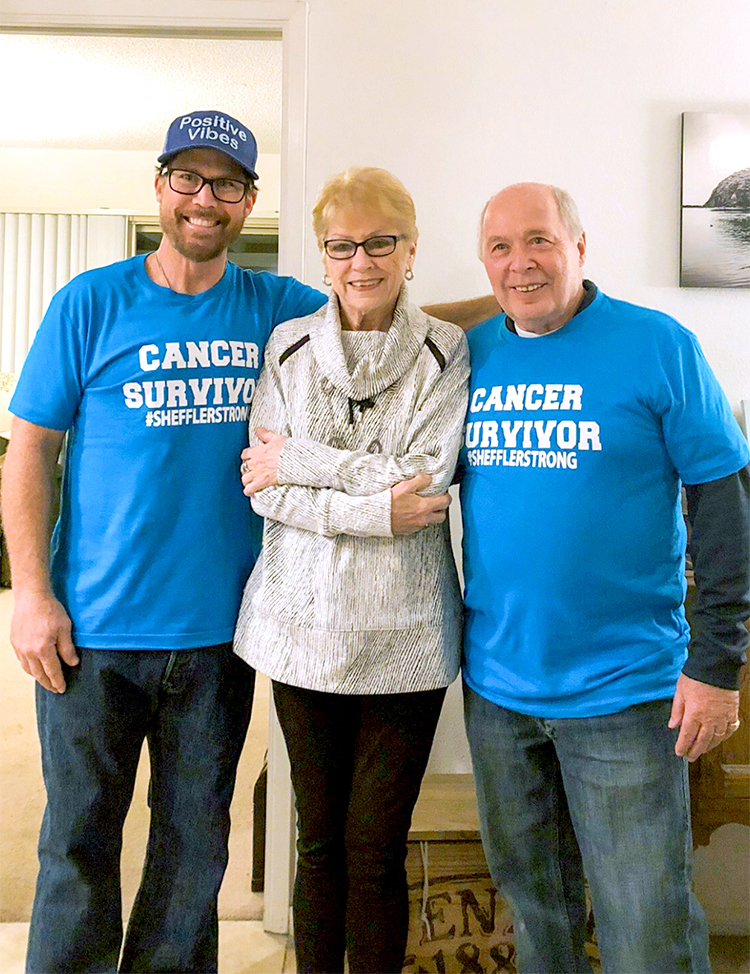ALMOST 40 YEARS AGO, 22-year-old Leonard Zasoski Jr. watched his 57-year-old father die of metastatic prostate cancer. His father had “prostate issues” for many years, but he never saw a urologist to be examined. By the time Zasoski’s father learned he had cancer, the rapidly growing and dividing cancer cells had spilled out from the prostate gland and spread throughout his body, forming a visible lump on his neck.

Leonard Zasoski and his wife, Betty, hold their grandson, Arlo, who was born in May 2021.
“I watched him go from a very healthy individual to curled up in a ball,” Zasoski says of his father. “They couldn’t give him enough pain medication.”
With his father’s experience in the back of his mind, Zasoski, who lives in Bakersfield, California, started getting screened for prostate cancer in his mid-30s, receiving annual prostate-specific antigen (PSA) blood tests and digital rectal exams. When he was 49, “all of a sudden, my numbers went up,” he says. His PSA level, a measurement of a protein in the blood that is produced by both normal prostate cells and malignant ones, went from 1.8 nanograms of PSA per milliliter (ng/mL) to more than 3.5 ng/mL. Zasoski went to a urologist in nearby Los Angeles. The first biopsy in July 2010 came back negative, but his PSA numbers kept climbing. After the second biopsy in March 2011, he got the call: He had prostate cancer.
There was an important difference between his diagnosis and his father’s, however. Zasoski’s doctors had caught the cancer early, and an examination of the biopsied tissue by a pathologist showed his tumor had a Gleason score of 6, which indicated a slow-growing cancer. His doctor suggested active surveillance, a standard option in early, low-risk prostate cancers. Under active surveillance, doctors would not immediately treat his cancer, but instead would monitor it carefully with PSA testing and do repeat biopsies to check for signs that the cancer was progressing or becoming more aggressive. Before deciding on this approach, Zasoski sought a second opinion. The second doctor took more time than the first, talking him through various options, including surgery, radiation and active surveillance.
“If there’d been no family history, I might have gone with active surveillance,” Zasoski says. But his decision was ultimately guided by the words of his second doctor who said, “You want to beat this? Take it out.” Zasoski knew there could be lasting effects from a radical prostatectomy, in which his prostate would be removed, and that the recovery wouldn’t be easy. Still, he decided to have the surgery.
Weighing Values and Risks
An estimated 250,000 men in the U.S. were diagnosed with prostate cancer in 2021. The vast majority of these men will survive their cancer. Research suggests men with prostate cancer have a five-year relative survival rate of 97.5%. In large part, that is due to the sensitivity of PSA to detect non-deadly prostate cancer that might go unnoticed or undiagnosed.
Thankfully, about 74% of prostate cancers are diagnosed when the cancer is in an early stage, meaning the tumor is confined to the prostate. In another 13% of cases, the cancer has spread to nearby lymph nodes, but people in these two groups are at no greater chance of dying within five years than those who don’t have prostate cancer. Just 7% of prostate cancers are diagnosed after they’ve spread to more distant parts of the body, which is known as metastatic cancer. These people have a greatly reduced five-year relative survival rate of approximately 30%.
Prostate cancer, especially of the slow-growing or indolent variety, is common. One in eight men will be diagnosed with prostate cancer at some point in their lives, according to statistics published by the National Cancer Institute’s Surveillance, Epidemiology, and End Results Program, which collects data to measure cancer burden in the U.S. But studies suggest that these statistics actually understate prostate cancer’s prevalence. For example, one study showed that approximately one-third of Caucasian men and more than half of African American men ages 70 to 79 who were autopsied after death had undiagnosed prostate cancer but died of other causes.
This research shows that, despite the high prevalence of prostate cancer, early detection and treatment aren’t always critical, because most prostate cancers grow slowly and never leave the prostate. This realization has led to a shift from screening most men as a matter of course to a more individualized approach, based largely on patient preferences and values.
“Current guidelines recommend discussion between the primary care provider and patient about the pros and cons of screening, and then individual decisions about whether [and when] to undergo it,” says Robert Abouassaly, a urologist specializing in prostate cancer at the Cleveland Clinic.
The U.S. Preventive Services Task Force suggests that men between 55 and 69 discuss the potential benefits and harms of PSA testing with their doctors before deciding whether and when to begin screening for prostate cancer. The rationale is that screening comes with the benefit of reducing the risk of prostate cancer death, but only for a small number of men who will go on to develop more aggressive cancer. Many men will instead learn their PSA levels are high, which could result in biopsies, additional testing, and treatments that may come with complications. The guidelines also recommend against screening men 70 and older because they are less likely to benefit from detecting and treating prostate cancer given their age, and because most prostate cancers aren’t deadly.
Guidelines issued by the American Cancer Society (ACS) recommend that men at average risk for developing prostate cancer discuss PSA screening with their doctors beginning at age 50. If their personal risk is higher, as is the case for Black men and men with a father or brother diagnosed with prostate cancer before age 65, ACS guidelines say discussions should begin earlier, at age 45. If the family history of prostate cancer is even stronger—having more than one first-degree relative with prostate cancer being diagnosed before age 65—ACS recommends men start to think about and discuss screening at age 40.
“It’s a complex decision that a man needs to make, especially knowing that hidden prostate cancer is very common in men as they get older and most may never cause harm,” says Elizabeth Platz, a cancer epidemiologist who co-leads the Cancer Prevention and Control Program at Johns Hopkins Kimmel Cancer Center in Baltimore. “Men have to figure in their values in wanting to know whether it is present or not.”
To Treat or Not to Treat
When PSA levels come back elevated, patients need to decide next steps, including whether to pursue a biopsy or imaging of the prostate. If cancer is detected and hasn’t spread, physicians will assess risk using a combination of factors, including the PSA level and tumor characteristics and an analysis of pathology to determine a cancer’s grade or Gleason score. These factors taken together will allow doctors to place the cancer on a scale from very low risk to very high risk.
Physicians will also consider the patient’s family history of prostate cancer. They may perform genetic testing for germline mutations in the BRCA1 and BRCA2 genes, which are known to increase the risk of aggressive prostate cancer. In addition, newer lab tests, including the Oncotype DX Genomic Prostate Score (GPS) assay, Decipher and Prolaris, can determine which genes are active within prostate cancer cells, to predict whether those cells will grow slowly or more aggressively. If the cancer is at an early stage and doesn’t appear to be aggressive, doctors often give people the option to hold off treatment and undergo a period of active surveillance.
No matter what option an individual with a low-risk prostate cancer chooses, the prognosis for early prostate cancer is very good. A landmark study reported in the New England Journal of Medicine in 2016 showed that mortality from prostate cancer at a median of 10 years after diagnosis with localized prostate cancer was low, irrespective of whether patients chose active surveillance, radical prostatectomy or radiation. More than 1,600 men in the study with localized prostate cancer were divided into groups based on their treatment choices. Seventeen died of the disease. Eight of 545 men in the active surveillance group died of prostate cancer compared to nine of 1,098 who had either surgery or radiation. However, more men in the active surveillance group showed disease progression or developed metastatic prostate cancer after 10 years of follow-up.
Beyond the risk that untreated early-stage prostate cancer may progress into life-threatening metastatic cancer, active surveillance can also be “psychologically challenging,” Platz says. “Some find that they can’t tolerate knowing they have cancer inside them.”
A study published Sept. 9, 2020, in BMJ Open analyzed interviews with 20 patients who were undergoing active surveillance and found that men who received reassurance when questions arose and built trust with their physicians were better able to manage the uncertainty of active surveillance. Overall, however, a number of studies reporting on quality of life for prostate cancer patients undergoing active surveillance showed that most men manage the uncertainty and extra monitoring well. Those who chose active surveillance had quality of life scores comparable to those of men who had chosen a radical prostatectomy.
Still, some who initially chose active surveillance will need to start treatment at some point down the road. A study published October 1, 2021, in the Journal of Urology shows that about half of men who picked active surveillance for low-risk prostate cancer went on to receive treatments, such as surgery, radiation or hormone therapy, within five years.
Those who opt for treating an early-stage cancer instead of active surveillance face yet another round of tricky decisions, based largely on their own personal preferences. The most common treatment options for early-stage prostate cancer are surgery or radiation. Radiation can be delivered externally with a machine for a period of weeks or internally by placing a radioactive seed in the body next to the tumor. Hormone therapy also may be an option as a way to block or remove testosterone and other androgen hormones that cause prostate cancer to grow. Focal therapy uses extreme temperatures or lasers to destroy cancerous tissue while leaving the rest of the prostate unharmed and is considered a middle-ground treatment option, falling somewhere between active surveillance and treatments intended to remove or destroy the prostate as a whole.
“We do not have any large head-to-head studies that compare treatments [to each other for localized prostate cancer]. It’s hard to say that any one treatment is the best treatment,” Abouassaly says.
Tackling Early-Stage, Aggressive Prostate Cancer
Pat Sheffler, who found out he had prostate cancer in March 2018 at age 53 after his PSA levels jumped from 4 ng/mL to 37 ng/mL in a year, participated in an ongoing clinical trial that combines three drugs to treat localized but aggressive high-risk prostate cancer. It wasn’t clear from MRI scans whether the cancer had spread beyond the prostate when he was diagnosed. Pathology showed his cancer had a Gleason score of 7, suggesting he still had a good prognosis but the cancer was more likely to grow.

In 2019, Pat Sheffler celebrated his father Tom’s 81st birthday with his mom, Bunny. His mother died in 2020.
Sheffler found out that his family history also put him at greater risk: His father was diagnosed and had surgery for prostate cancer at age 72—which Sheffler only learned about after his own diagnosis. Sheffler’s oncologist at the University of California, San Diego, invited him to take part in a clinical trial that tested a new approach to treat localized but high-risk prostate cancer. He received a combination of three drugs to block androgen hormones that feed the cancer’s growth, along with a steroid. Sheffler’s PSA dropped to 0.2 ng/mL after six months on the hormone therapy. By the time he had his prostate removed along with some surrounding tissue and 16 lymph nodes, his tumor was nearly gone.
After surgery, he continued on the trial, staying on the hormone therapy for another year. His treatment ended in January 2020 and he has no signs of cancer. Sheffler celebrated the end of treatment by running a 5-mile Spartan race, a series that includes running while overcoming obstacles, with his family. Two of his three brothers have since been diagnosed with localized, low-risk prostate cancer and opted to have their prostates removed because of their strong family history. Sheffler looks to raise awareness of prostate cancer and screening as an advocate with the Prostate Cancer Foundation, which provided financial support for the clinical trial he participated in.
Zasoski is now a 10-year prostate cancer survivor. He acts as a mentor to others through the patient advocacy organization Zero – The End of Prostate Cancer. He and Sheffler both encourage men to get their PSA levels checked annually, even if the chances of finding an aggressive prostate cancer are slim.
“It’s devastating to have [prostate cancer and surgery to remove the organ], but if it got rid of the cancer and I can see my son and daughter and grandkids grow up—I can live with that,” Zasoski says.
Cancer Today magazine is free to cancer patients, survivors and caregivers who live in the U.S. Subscribe here to receive four issues per year.






